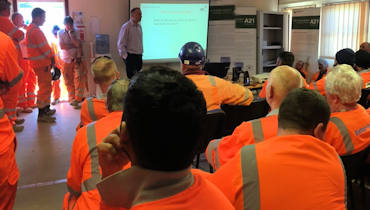Richard writes:
This week I gave a presentation on manual handling awareness at the Balfour Beatty A21 Tonbridge to Pembury road widening project.
In fact, I held two presentations. One at 07.00 attended by the workforce and supervisors, and one at 08.00, attended by site engineers and office management.
The course is one of our 15 short presentations. Each presentation lasts 20 to 30 minutes. They are not full training courses, but rather they give an awareness to anyone on a project of risk management in various fields. The attendees are not restricted to only VGC Group personnel – everybody on a project is very welcome.
Today’s presentation was seen by a total of about 75 people. It included defining manual handling, the risks involved, and control measures that can be used, as well as describing what injuries can result. It covers not just workplace activities, but also home life activities.
HSE figures show that over a third of all reportable injuries involved manual handling in some form.
Manual handling is not just about lifting.
It involves the movement of any object by bodily force including pushing, pulling and carrying.
This is one of the most significant risks facing the construction industry today, yet awareness surrounding it is limited. Once you have an injury such as a back injury, the effects can last for a long time, even becoming life-changing. But we still expect our workforce to undertake it.
Activities such as shopping and gardening can create a weak spot. Then, while at work, a small activity can result in the injury becoming evident, and potentially resulting in time off work. It can even generate a RIDDOR.
There is evidence that manual handling, including heavy manual labour, awkward postures and a recent or existing injury are all risk factors in the development of musculoskeletal disorders (MSDs). The Manual Handling Operations Regulations 1992 (MHOR) require employers to manage the risks to their employees. They should:
- avoid hazardous manual handling operations so far as is reasonably practicable
- make a suitable and sufficient assessment of the risk of injury from any hazardous manual handling operations that cannot be avoided
- reduce the risk of injury from those operations so far as is reasonably practicable.
As well as workers knowing how they can injure themselves from poor manual handling techniques, site engineers and project management need to understand manual handling when they plan works. It is important not to overlook manual handling as a risk factor.
Other presentations

Other presentations include mental health, traffic and vehicle movements, behaviour based safety, buried services, fatigue and sleep deprivation, bribery, corruption and ethics, ecology and sustainability. If you want further information, please contact HSQE at our head office in Ruislip on 08456 201201.
Save
Save
Save
Save
Save
Save
Save
Save
Save
Save

